|
圖片來源: Jones et al. 2012, MNRAS, 427, 3209

Three infrared spectra taken by the Spitzer Space Telescope, showing the characteristic features of amorphous (at 10 and 18 micron) and crystalline (at 23, 28 and 33 micron) silicates seen in mass-losing Asymptotic Giant Branch stars. The spectra are ordered by increasing mass loss. The crystalline silicate feature at 33 micron becomes progressively stronger as the mass-loss rate goes up, while the 23 micron feature starts to go into self-absorption due to optical depth effects.
|
| Crystalline silicates are often found in the circumstellar environment of oxygen-rich Asymptotic Giant Branch (AGB) stars. The detection of these features depends on the wind density that these stars develop, but it seems that above a certain mass-loss rate threshold, crystallization of the newly formed silicates occurred. Until recently, it remained a mystery whether the crystallization was an effect of the wind density, in the sense that denser winds were more likely to condense crystalline silicates directly, or that crystalline silicates form due to the annealing of already formed amorphous silicates. In order to address this question, Manchester-based research Libby Jones and IAA-researcher Ciska Kemper compiled a sample of oxygen-rich AGB stars in the Milky Way, the Large Magellanic Cloud, and the Small Magellanic Cloud, representing three different metallicities, and thus three different dust-to-gas ratios in their circumstellar shells. A sharp transition in the detection of crystalline silicate features as a function of either the gas mass-loss rate or the dust mass-loss rate, will point towards the direct condensation or the annealing of amorphous silicates as the formation mechanism of crystalline silicates. Jones and Kemper and their collaborators found that the annealing of amorphous silicates was more likely, indicating that stars first form amorphous silicates, which, when the winds is sufficiently dense will get crystallized by irradiation from the central star. |
 asiaa.sinica.edu.tw 媒體連絡: epo
asiaa.sinica.edu.tw 媒體連絡: epo asiaa.sinica.edu.tw
asiaa.sinica.edu.tw